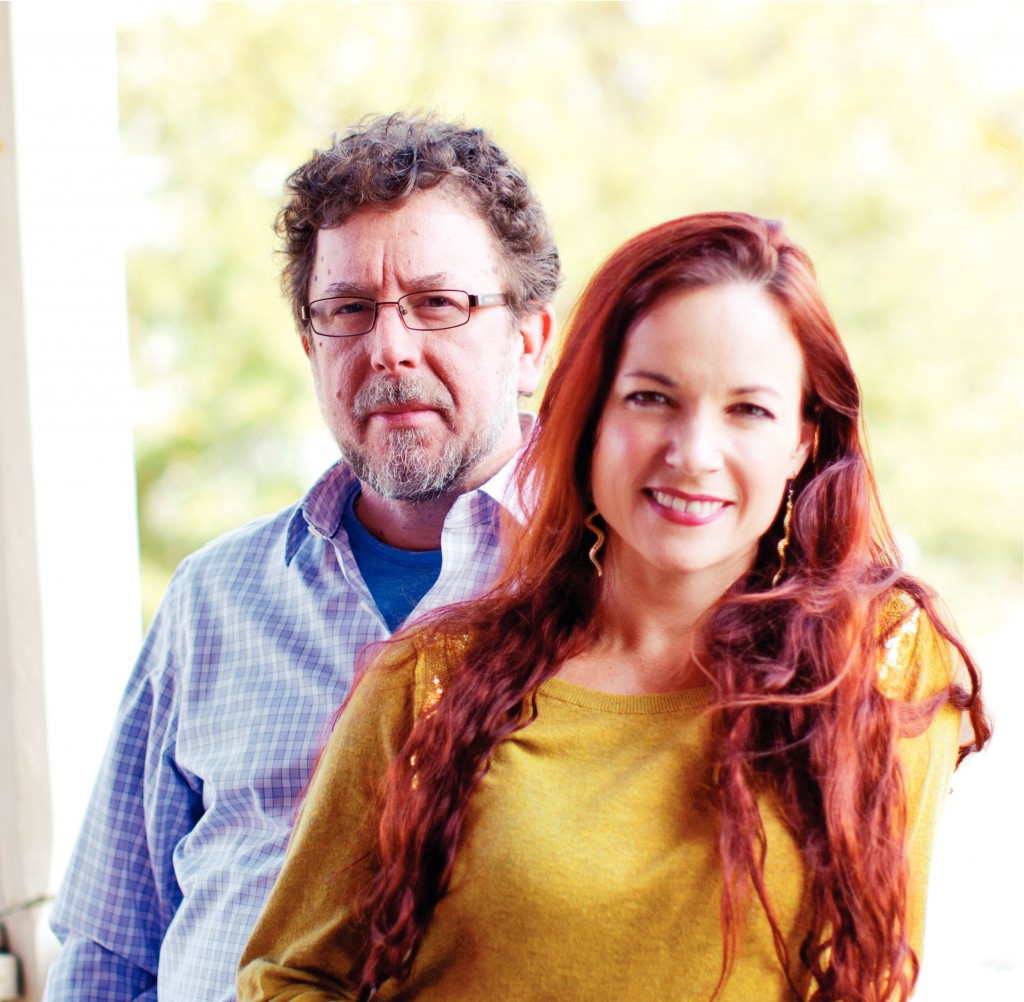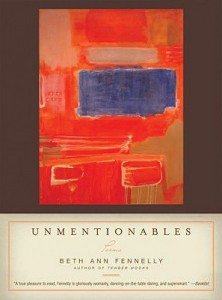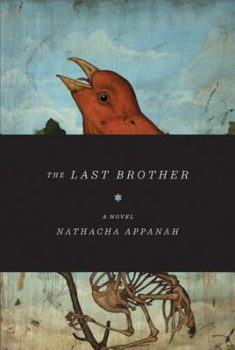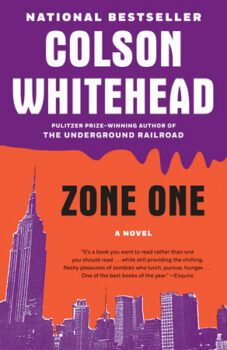I met with Tom Franklin and Beth Ann Fennelly in their home the Friday after Labor Day. It was one o’clock in the afternoon and their youngest son was asleep in his room. His toys were scattered on the floor. I’d been over at the house a few nights earlier for a party and my son had played furiously with a little police motorcycle that he’s come to think of as his own (we lived in the Franklin-Fennelly house for three weeks last summer when we were between places and they were in Europe). My wife and I carried him away from the party after midnight, wide awake, reluctant to leave. And that’s how I often feel at their house. Reluctant to leave. At home.
The living room, the recently renovated kitchen, and the dining room are one big space. There are paintings on the wall—one of Tom, one of each of the three children, a family portrait by Lamar Sorrento—and the room is bright and open with high windows and full bookshelves. A large chair made to resemble a face, looking like it’s straight out of a Dario Argento film, is a recent addition. The room always smells faintly of the fireplace, even in summer, and it’s a comforting smell; like so much else about the house and the people in the house, it is warm and inviting.
Tom and Beth Ann were both my teachers in the MFA program at the University of Mississippi. I’ve known them for almost five years now, and—though I graduated in 2011—I still live in Oxford and see them often. I was around, at least peripherally, for some of the making of this book, and now that The Tilted World (William Morrow) is hitting shelves this week, I’m excited to go out into the streets and holler about how damn great it is. This isn’t a review, thankfully. If it was, it would consist of sloppy gushing. Hell, I guess there’s some of that here anyway. But you’ll have to forgive me. These are two of my favorite writers and two of my favorite people and they’ve written a gorgeous book.
I’m still (and will always be) caught up in being their student, so the nature of my questions here is one of inquisitive awe. Something like: How do you make things the way you do? Because I want to learn to make things the Franklin-Fennelly way. I want to create something that swings with heart like this novel does. I want to create something that pulses with tension and feels beautifully epic. The Tilted World put me in mind of Walter Macken’s great Irish Trilogy in its scope. It’s historical fiction that rumbles with fierce energy and walks the line between realistic intensity and allegorical myth-making. It’s also that rarest of things, a collaborative novel without breaks in tone and style, a book that is more than merely a book, a book that is an act of love.
Interview:
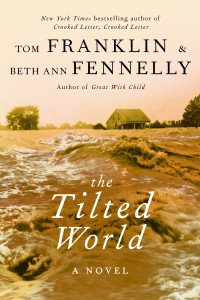 William Boyle: Could you start out by talking a little about what the collaboration process was like for The Tilted World?
William Boyle: Could you start out by talking a little about what the collaboration process was like for The Tilted World?
Tom Franklin: We started with our history together. We had been helping each other for so long. Beth Ann’s fingerprints are all over everything I’ve written since 1994.
Beth Ann Fennelly: Well, only the good parts.
TF: That’s right. She helps me to a larger extent than I help her because she’s far more familiar with fiction than I am with poetry. So, for the last fifteen years, she’s been editing things that I’ve written and discussing things in every stage of the process. And that engendered for us a kind of confidence in one another, as well as a faith in each other. I know that anything Beth Ann tells me about work I’ve done is going to be said for the right reasons. We have the same goal in mind. There are no ulterior motives; it’s just to make the best thing that we can. And, because of this history, this long history, we’re not sensitive with each other. We’re not cruel with each other either. We’re kind of dancing. We get right to the act. We’re right there working every time.
BAF: One question I’ve gotten from a lot of people is: “How do you make your voices sound similar?” Or: “How do you work out the roughness of the transitions?” The funny thing is it wasn’t really that hard. I’ve basically been in a writing workshop with Tommy ever since we met. I know his voice really, really well, so I don’t think it’s a big surprise that when I turned to writing fiction it came out in a voice that’s congruent with his.
WB: I was definitely struck by that, by the twining of the voices. Knowing you guys and knowing your work, there weren’t many moments where I thought, “Oh, that’s definitely Tommy. Or, that’s definitely Beth Ann.”
TF: You can tell the baby parts are Beth Ann. Even if you’d taken my hand and guided it on the page, I couldn’t have written that. I think it’s fair to say this: In this book, Beth Ann sort of rose to the position of leader, of pilot, and I took the position of co-pilot, a follower if you will. Happy follower, happy co-pilot, necessary and there. My voice is in her voice, and I think that accounts for the book seeming so pure in its tone. As far as the language goes, we’re kind of similar in that we both really like clarity. We don’t want to waste any words. We’re both very much about cutting. Anything we can cut, we do, and joyously. Also, we both love lyricism. And so we both go for, hopefully, a very clear page with the right amount of lyricism here and there.
BAF: Another thing that probably helps our voices harmonize is that we like the same writers. So often I read a book and pass it to you or vice versa.
TF: We wrote much of the book side-by-side. We’d start by discussing the scene we’d write for the day. Then I’d write it on my computer and she’d be two feet away writing it on hers. We’d email it back and forth and then I’d read hers and she’d read mine and we’d talk about what worked and take the best from both.
WB: I don’t know the history of “What His Hands Had Been Waiting For” [the collaborative short story on which the novel is based]. Did you write it for a specific anthology or was it just something you decided to write together?
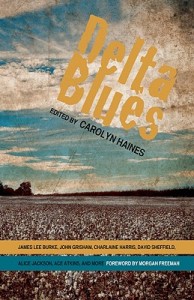 BAF: Well, you know how most writers keep that drawer of failed drafts? Not the ones that have to be entirely ditched—the ones you keep because there’s something there, but they just never quite worked. The writer Carolyn Haines asked Tommy to contribute to an anthology of Mississippi blues stories. A year in advance it was easy to say yes. And then, of course, the deadline comes and he’s got nothing. So he starts going through that drawer, and I’m hanging out. He picks up one and says, “This is an old zombie story. I know it’s a failure but I swear to God there’s something here.” I read it and there is something there. It doesn’t work as a story, but I never wanted to stop reading it. I was interested. It was this really bizarre, post-apocalyptic setting. The zombie apocalypse. There are two rangers, they discover this baby, they keep going and find a woman to give it to. It seems like something bad is going to happen. There’s a kind of bad guy there, you’re not exactly sure who he is. And then the story is over.
BAF: Well, you know how most writers keep that drawer of failed drafts? Not the ones that have to be entirely ditched—the ones you keep because there’s something there, but they just never quite worked. The writer Carolyn Haines asked Tommy to contribute to an anthology of Mississippi blues stories. A year in advance it was easy to say yes. And then, of course, the deadline comes and he’s got nothing. So he starts going through that drawer, and I’m hanging out. He picks up one and says, “This is an old zombie story. I know it’s a failure but I swear to God there’s something here.” I read it and there is something there. It doesn’t work as a story, but I never wanted to stop reading it. I was interested. It was this really bizarre, post-apocalyptic setting. The zombie apocalypse. There are two rangers, they discover this baby, they keep going and find a woman to give it to. It seems like something bad is going to happen. There’s a kind of bad guy there, you’re not exactly sure who he is. And then the story is over.
TF: They were going to eat the baby was the implication.
BAF: Yeah, it was just slightly over the top. So I said, “You’re right, Tommy. There really is something here.” And we started talking about possibilities for it. And he said, “You know, I made a promise I’d get a story in, but I don’t really have time to even work on this. But it seems like you have some ideas. Why don’t you see if you can work on it?” So I did work on it and e-mailed it back to him and he worked on it and e-mailed it back to me and this kind of kept on.
TF: Beth Ann did a ton of research, too. On the flood. That’s what the story needed, its real setting. It wasn’t the zombie apocalypse, it was the Flood of 1927.
WB: So you made that decision to switch it to the flood, Beth Ann?
BAF: Well, actually, Carolyn Haines had said to Tommy, “What about the flood as a setting?” And we had already been talking about the flood post-Katrina as this really interesting historical period that not many people knew about. So it had been in our minds, and when she suggested it, it felt right.
The problem with zombie stories for me is there aren’t real consequences. I like people. I don’t think you need zombies to make things weird. People are weird. They’ll do anything. So, making the zombie landscape the flooded Mississippi Delta was all we needed to write the story.
And the story ended up doing really well. We were published in a couple of anthologies. We didn’t really think that much about it. By then we were both on other projects. But Tommy’s agent—who, ironically, is married to my agent, Nat Sobel and Judith Weber—called Tommy one day and said, “Well, I just read this story. Why didn’t you tell me about it?” Tommy said, “What’s there to tell? It’s a tossed-off, one-time thing.” Nat said, “No, it’s not. It’s your next novel and you and Beth Ann should write it together.” So it was Nat’s idea.
 It seemed crazy. I didn’t want to write a novel, or write a novel with Tommy necessarily. But I’d done so much research for the story and it was so interesting. Not being able to use more of it almost felt frustrating. I just couldn’t believe how rich that stuff was. And, at this point, a year’s gone by and those characters were still a little bit in our heads. There’s some way that this story was continuing on subconsciously. So, we agreed to do it and we said we’d have a draft in a year. It took us three years. In the meantime, things slowed down a little bit when we got knocked up again. Tommy went out on a book tour, which was a big break in the proceedings.
It seemed crazy. I didn’t want to write a novel, or write a novel with Tommy necessarily. But I’d done so much research for the story and it was so interesting. Not being able to use more of it almost felt frustrating. I just couldn’t believe how rich that stuff was. And, at this point, a year’s gone by and those characters were still a little bit in our heads. There’s some way that this story was continuing on subconsciously. So, we agreed to do it and we said we’d have a draft in a year. It took us three years. In the meantime, things slowed down a little bit when we got knocked up again. Tommy went out on a book tour, which was a big break in the proceedings.
TF: And the tour kept lengthening and lengthening. I kept doing speaking engagements.
BAF: So, eventually we got it done, and it was fun to write.
TF: It was fun. What was really fun was writing it together, which I guess is not surprising but we hadn’t thought about it. Writing it separately felt like writing anything, and I never could quite get through. But writing it together in the same room, I kind of fell into Beth Ann’s groove a little bit. Just by sheer proximity.
WB: Did you guys research together, too?
BAF: Well, I did the research. But the truth is when we began this project I wasn’t sure I could write half a novel. Tommy knew he could because he’s written novels by himself. What I knew I could bring to the table was being an “A” student. Like being a good waitress in high school. I’m not going to forget about any details, and I’m not going to screw up the little things. I didn’t know if I could make art, but I knew I could get the historical facts right. And I loved the research. The research was so fun, in fact, that it was almost dangerous. Because there comes a point when you realize that more research isn’t going to help the novel. More research is another word for procrastinating.
WB: Was the process different than researching for your poetry and non-fiction?
BAF: I wouldn’t say the research process is any different at all. I’ve written poems set in different historical periods and researched by reading books and searching the Internet. The novel research was just more extensive. And, since it happened in Mississippi, we could go to the places. We could go to where the levee broke. We could go to the Flood Museum. One of my non-traditional students told me about having her grandmother’s photographs, and I looked at those. I looked at weird documents and letters online. And diaries. All different stuff. Which helped not only the details, frankly, but getting the rhythm of the language in my head and some of those country expressions.
TF: David Milch, on the Deadwood DVD, says: “Read all the primary materials. All of them. And then forget about them and write.” To an extent, that’s what we’re talking about. But, also, there’s Google. We could always look things up right away. What’s this? Had this been invented? What was it called? We did a bit of that, too.
WB: Did you guys always know that it would be a love story? Hearing that it started as a zombie story is especially fascinating in light of what it became. Did you know that the flood would just be a backdrop for this other story, this love story between Dixie and Ingersoll but also this love story between Dixie and Willy.
BAF: When I got involved I think those things were a little more ordained.
TF: What a nice word, “ordained.”
BAF: Tommy always said he wanted to work more on having really compelling female characters. To be frank, Tommy’s first novel, Hell at the Breech, was about a men’s war. There was the midwife but there just weren’t a lot of female characters involved. It’s not that he made the choice not to have them in there. They just weren’t all that involved. There are strong mothers in Crooked Letter, Crooked Letter, but the primary characters in all of his books are men, with the possible exception of Evavangeline in Smonk.
TF: Who’s more of an animal than a human. Doesn’t count.
BAF: I have always thought: Where are our big stories? Where’s our big drama? We tend to think of war, but I actually think our big dramas take place in the human heart. There are cool things I’ve done—we went into the favelas in Rio and saw people with guns, I’ve lived in Prague, I hiked miles into a cave in Belize to see human skeletons from Mayan sacrifices—yet what’s the wildest thing I’ve ever done? Absolutely, bar none, giving birth. That was wild. When I think about things that transformed me as a person, I’d have to say: falling profoundly in love with Tommy and becoming a mom are the two things that did the most to change my essence. So writing about a strong female character and allowing her an arc of character that is brought about through love and motherhood—that’s not so much a political decision as just a truth. As much of a natural disaster as a flood is, falling in love is also a natural disaster. Or it can be.
WB: Having never written anything that’s historically based, I can’t imagine not being overwhelmed by the scope of it. I was wondering what pulls you into wanting to write a historical novel? And what are the pitfalls? Tommy, pretty much everything you’ve written is historical, except for certain stories in Poachers and parts of Crooked Letter, Crooked Letter.
 TF: The draws are that you can recreate a different time. There are so many things about our time that I don’t like. All the cell phones. All the electronics. It just seems like such a purer time, when you had to walk places or go on horses. In a way, it’s really fun to evoke that time and really hard and really challenging to get it right. Sometimes you can just word something differently and it sounds right. And sometimes you have to really dig. For someone like me, who doesn’t like to research, it’s kind of a scary proposition to write historically, and I never planned on it. I didn’t plan on writing this book and setting it in 1927. I wrote a zombie story set in the future, which is easy to imagine. They were on motorcycles in that story. When I did Hell at the Breech, I had a lot of knowledge of that time period, 1897. That was why I moved into Smonk after, because I had a lot of stuff leftover. I knew so much about the clothes and everything else; it would’ve seemed almost wasteful not to use it. But Smonk’s such a weird book and I got caught in that tone—not in Crooked Letter, Crooked Letter because it’s contemporary—but in the next historical book, this book, the flood book. Suddenly I was writing Smonkian things. I remember this was Beth Ann’s term. She would say, “You’re writing Smonkian again.” And she was right. There’s a part where Ingersoll tries to give the baby to the orphanage keeper in Greenville, and in my version of that he’s a creepy pedophile, rubbing his hands and saying, “Give me the baby.” Beth Ann’s was just a harried clerk, which was so much more realistic, and it accomplished the same thing. Ingersoll did not give the baby up. He wanted to keep it. It doesn’t matter if you have this pedophile or this busy clerk; it’s the same thing. You see where I went and you see where she went. And, of course, where she went was the right venue, which is why she’s the captain. Or, I should say, the director. Right now I don’t want to write another historical novel. I want to write something set in the ‘90s, when there are no cell phones.
TF: The draws are that you can recreate a different time. There are so many things about our time that I don’t like. All the cell phones. All the electronics. It just seems like such a purer time, when you had to walk places or go on horses. In a way, it’s really fun to evoke that time and really hard and really challenging to get it right. Sometimes you can just word something differently and it sounds right. And sometimes you have to really dig. For someone like me, who doesn’t like to research, it’s kind of a scary proposition to write historically, and I never planned on it. I didn’t plan on writing this book and setting it in 1927. I wrote a zombie story set in the future, which is easy to imagine. They were on motorcycles in that story. When I did Hell at the Breech, I had a lot of knowledge of that time period, 1897. That was why I moved into Smonk after, because I had a lot of stuff leftover. I knew so much about the clothes and everything else; it would’ve seemed almost wasteful not to use it. But Smonk’s such a weird book and I got caught in that tone—not in Crooked Letter, Crooked Letter because it’s contemporary—but in the next historical book, this book, the flood book. Suddenly I was writing Smonkian things. I remember this was Beth Ann’s term. She would say, “You’re writing Smonkian again.” And she was right. There’s a part where Ingersoll tries to give the baby to the orphanage keeper in Greenville, and in my version of that he’s a creepy pedophile, rubbing his hands and saying, “Give me the baby.” Beth Ann’s was just a harried clerk, which was so much more realistic, and it accomplished the same thing. Ingersoll did not give the baby up. He wanted to keep it. It doesn’t matter if you have this pedophile or this busy clerk; it’s the same thing. You see where I went and you see where she went. And, of course, where she went was the right venue, which is why she’s the captain. Or, I should say, the director. Right now I don’t want to write another historical novel. I want to write something set in the ‘90s, when there are no cell phones.
WB: What about audience? Were you guys thinking about appealing to each other’s audiences? Was that on your mind as you worked on this?
 TF: I was thinking about the fact that Beth Ann would hopefully bring more female readers. Crooked Letter, Crooked Letter brought me a ton. I look at the reviews on Amazon and nine out of ten are by women. I mean, obviously, women buy more books and they must crave strong female characters, which I hadn’t provided. And now, by God, do they have one thanks to Beth Ann and Dixie Clay. So I do think that The Tilted World will expand my readership and hopefully it will expand Beth Ann’s.
TF: I was thinking about the fact that Beth Ann would hopefully bring more female readers. Crooked Letter, Crooked Letter brought me a ton. I look at the reviews on Amazon and nine out of ten are by women. I mean, obviously, women buy more books and they must crave strong female characters, which I hadn’t provided. And now, by God, do they have one thanks to Beth Ann and Dixie Clay. So I do think that The Tilted World will expand my readership and hopefully it will expand Beth Ann’s.
BAF: A) What readership? Poetry has none. B) I wasn’t really thinking about an audience when we were writing it. We’re thinking about it now when we’re trying to market it and we have to answer these questionnaires for our publisher. At the time, we were just writing and it was fun.
TF: It was fun, but I think I had expanded female readership in mind. I think that’s one of the things that drew me to the idea of writing the book together. In a mercenary sense, that did occur to me.
WB: Hobnob Landing is a fictional town, but I know you visited the place where the levee broke and you know Mississippi so well. You used a lot of local names in the book. Was that just a fun thing you were doing in terms of making the town?
BAF: It was nothing but silly-for-us fun. It wasn’t about making it realistic or expanding readership or anything. In poems you don’t get many names and in novels you do. I remember reading a book by our friend Dennis Lehane. We have a mutual friend, Tom Bernardo, and in Dennis’s novel there’s a character named Bernardo Tom. I just loved that fiction writers could do that, and I was always a little jealous of it. And Tommy had done it a little in his previous novels. In fact, before I dated Tommy, I had a Scottish boyfriend who broke my heart and dumped me. His name was Colin, and in all of Tommy’s novels, a character named Colin is violently killed. When work started on The Tilted World, I started using a lot of names just because I could and then we both started doing it and it was really fun. In this book, the Colin character is the Scottish clerk who is shot by looters. That scene actually fell to me to write, so I’m the one who killed Colin in this novel, not Tommy.
Further Links and Resources:
- For more on Tom Franklin’s books, visit his Harper Collins author page.
- To hear more about Beth Ann Fennelly’s work as an essayist and poet, read her recent Prairie Schooner interview.
- You can also read Brad Wetherell’s 2011 FWR review of Franklin’s Crooked Letter, Crooked Letter.
- Or, check out the work of Memphis artist Lamar Sorrento.
Contributor:
 William Boyle is from Brooklyn, NY and currently lives in Oxford, MS. His first novel, Gravesend, is forthcoming from Broken River Books. His writing has appeared in The Rumpus, Salon, L.A. Review of Books, Hobart, Vol. 1 Brooklyn, and other magazines and journals.
William Boyle is from Brooklyn, NY and currently lives in Oxford, MS. His first novel, Gravesend, is forthcoming from Broken River Books. His writing has appeared in The Rumpus, Salon, L.A. Review of Books, Hobart, Vol. 1 Brooklyn, and other magazines and journals.

